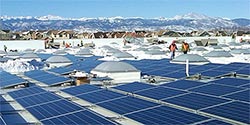Week in Review: Solar surging forward
 The majority of solar news last week was positive, with utility-scale projects starting to make significant headway and incentive programs taking off. However, its not all sunny skies for solar today and tomorrow. One new report found that the issues plaguing solar will cause some cloudy skies for the industry in 2012.
The majority of solar news last week was positive, with utility-scale projects starting to make significant headway and incentive programs taking off. However, its not all sunny skies for solar today and tomorrow. One new report found that the issues plaguing solar will cause some cloudy skies for the industry in 2012.
A recent Lux Research report found that growth in the solar industry will be hampered in 2012, growing just 0.4 gigawatts over 2011 to 26.9 gigawatts of new installations in 2012. The industry’s growth is being slowed on the manufacturing side by a continued oversupply of modules and on the installation side by falling and ending incentives. However, after this corrective year, growth in solar is expected to resume, with annual installations across the world expected to grow to 38.3 gigawatts in 2017.
However, in some senses the industry doesn’t really seem to be taking too much notice. For instance, 8minutenergy Renewables just got the go-ahead for 600 megawatts 600 megawatts of solar installations in California as well as the go-ahead from the Imperial County Board of Supervisors. The projects are being developed on previously used farmlands and are being designed to have little negative environmental impact.
Meanwhile other utility-scale projects are moving ahead as their financing comes through. For instance, Exelon’s 230 megawatt Antelope Valley Solar Ranch One received its first loan dispersement through a federal loan guaranteed by the U.S. Department of Energy's (DOE’s) Loan Programs Office. Thanks to the disbursement Exelon finalized its ownership of the project being developed by First Solar.
Similarly the Imperial Solar Energy Center South (ISEC-South), Tenaska’s 130 megawatt photovoltaic recently closed a $500 million round of debt financing led by the Bank of Tokyo-Mitsubishi UFJ, and Union Bank, N.A. The project also uses First Solar modules. Construction on the project began last year.
Realizing the potential profits leasing land to a solar project can bring, the Arizona State Land Department has started pursuing contracts on lands it manages. The majority of money raised will support public schools in Arizona. Most recently it signed an agreement with Arizona Public Service to build a 35 megawatt project on 400 acres of publicly managed land.
On the other side of the country things are moving along as well. Connecticut’s first, $2.5 million round of incentives under its Residential Solar Investment Program was introduced last month, and it’s been popular. The state approved 126 projects which will use $1.4 million in state incentives, as of April 5.
Though the price of solar continues to drop, incentives are still making all the difference. The Gloucester City Marine Terminal, currently the largest single rooftop installation in North America received more than $11 million in tax rebates earlier this year for its $42 million, 9-megawatt rooftop solar array.
One of the ways solar is gaining traction is by introducing more people to solar. That was the purpose of the EcoFocus show in New York last week. The show introduced and showcased all manner of renewable energy-based gadgets that use renewable energy. Many of the tools and gadgets are used by people going into developing nations.
Retail giant Walmart just completed its 100th solar array when it completed six installations in Colorado. Its newest installations were installed through a partnership with SolarCity and total two megawatts along Colorado’s front range. Three are in Westminster. The others are on stores in Lakewood, Highlands Ranch and Lafayette.



